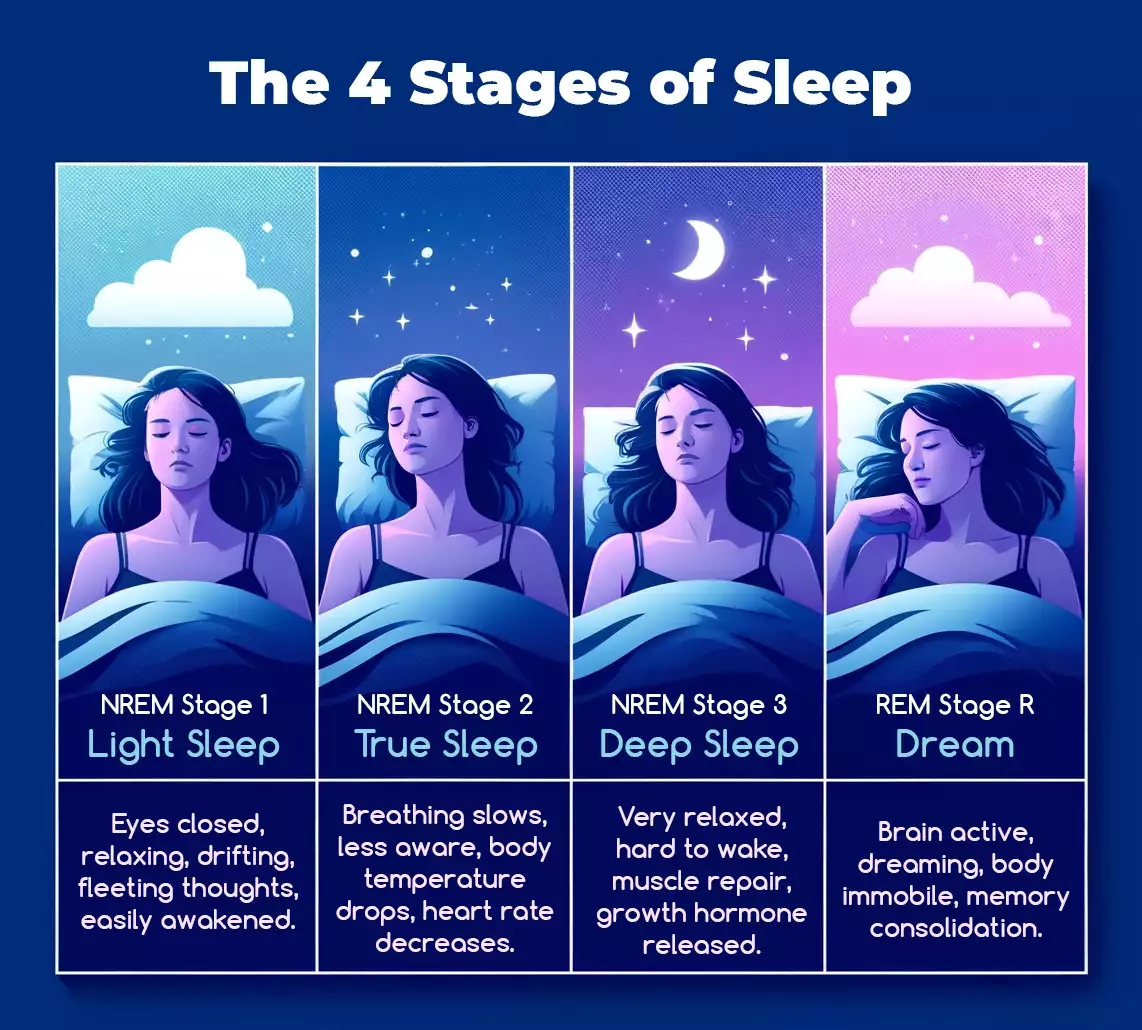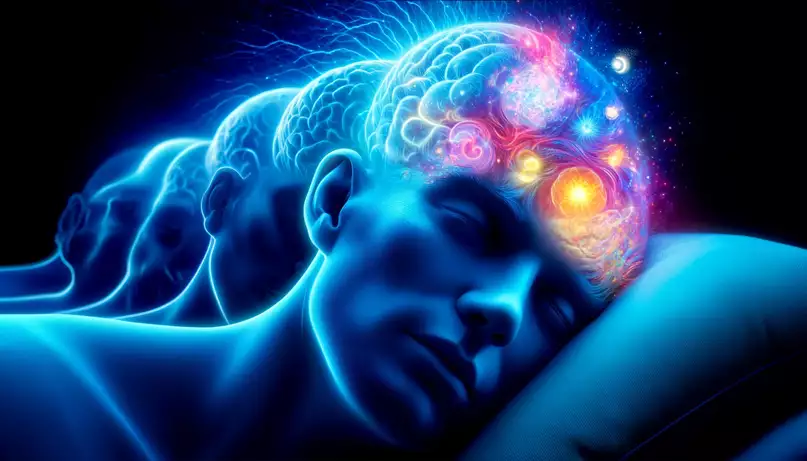Understanding the 4 stages of sleep is essential for appreciating how our bodies and minds rejuvenate each night. Each stage of sleep serves a specific purpose in maintaining our health and well-being.
From drifting off to the lightest stage to deep sleep and finally, the dream-rich REM stage, this article will explore what happens during each phase. Learning about these stages can help us recognize the importance of a full night’s sleep and how it aids in our daily functioning and long-term health.
Stage 1: The Threshold of Sleep – Light Sleep
Stage 1 of sleep, also known as N1, serves as the gateway between wakefulness and sleep. This initial phase is characterized by light sleep from which one can easily be awakened.
Typically lasting only 1 to 7 minutes, it involves a notable decrease in muscle tone and a slowing of the eyes. This stage is often accompanied by sudden muscle twitches, known as hypnic jerks, which can occasionally startle individuals back to wakefulness.
During this phase, the brain produces theta waves, which are slower and higher in amplitude than the alpha waves that dominate the waking state. The transition to sleep in this stage can be compared to the sensation of gently falling or drifting that many people report experiencing as they begin to fall asleep.
This stage is critical for setting the stage for deeper sleep, allowing the body to begin its nightly healing processes.
Stage 2: Consolidation and Preparation – True Sleep
Stage 2, or N2, deepens the sleep cycle, typically lasting from 10 to 25 minutes during the first cycle and extending in subsequent cycles throughout the night. This stage marks a period of light sleep before you enter deeper sleep.
Your heart rate begins to slow, and your body temperature drops, preparing you for deep sleep.
Significantly, Stage 2 sleep is characterized by the occurrence of sleep spindles and K-complexes. Sleep spindles, brief bursts of brain activity, are believed to play a role in sensory processing and long-term memory consolidation.
K-complexes, which are single, large delta waves, are thought to be involved in memory consolidation as well and help protect the brain’s sleep state by providing a bridge to deeper sleep stages. An example of the importance of this stage can be seen in students or professionals who find improved performance after naps that include sufficient N2 sleep, illustrating the role of sleep spindles in consolidating new information.

Stage 3: Deep Sleep
Stage 3, or N3, known as deep sleep or slow-wave sleep, is the most restorative part of the sleep cycle. Lasting roughly 20 to 40 minutes in the first cycle, it features the slowest brain waves during sleep, known as delta waves.
During this stage, your body becomes less responsive to external stimuli, making it difficult to wake up. The body repairs muscles and tissues, stimulates growth and development, boosts immune function, and builds up energy for the next day.
The significance of deep sleep extends beyond physical restoration. For instance, children and teenagers may spend more time in N3 sleep, which supports their developmental needs.
On the other hand, older adults tend to experience shorter periods of deep sleep, which may affect their overall sleep quality and restoration.
Stage R: REM Sleep – The Dream Stage
REM sleep, the final stage of the sleep cycle, is where vivid dreams occur most frequently. This stage is marked by rapid eye movements, increased respiration rate, and brain activity that mirrors wakefulness.
Beginning roughly 90 minutes after falling asleep, REM sleep cycles initially last only a few minutes but can extend up to an hour as the night progresses.
During REM sleep, the brain consolidates information learned during the day into long-term memory and processes emotional experiences, which can influence mood and stress regulation. The paralysis of muscles, excluding the eyes and respiratory muscles, prevents us from acting out our dreams.
An example of REM’s importance is seen in studies linking adequate REM sleep to improved problem-solving skills and creativity.
Each stage of sleep plays a crucial role in cognitive and physical health, contributing uniquely to the body’s complex process of self-maintenance and repair. Understanding these stages helps underscore the importance of a good night’s sleep and provides insights into various sleep disturbances and their potential remedies.
The Impact of External Factors on Sleep Stages
External factors significantly influence the progression and quality of the four sleep stages. Elements such as light exposure, lifestyle choices, and stress levels can disrupt the natural sleep cycle, leading to sleep fragmentation and reduced sleep quality.
For instance, exposure to blue light from screens before bedtime can suppress melatonin production, delaying the onset of sleep and reducing time spent in deep and REM sleep stages. Similarly, consuming caffeine or alcohol close to bedtime can alter sleep architecture, decreasing the duration of deep sleep and disrupting the REM stage.
Environmental factors such as noise, temperature, and bedding comfort also play critical roles. Optimal sleep environments are quiet, dark, and cool.
Disruptions like loud sounds or uncomfortable temperatures can prevent the progression into deeper sleep stages, particularly N3, where the most restorative processes occur. Personal habits, such as irregular sleep schedules, can shift the body’s internal clock, affecting how quickly and efficiently one moves through the sleep stages.
This chapter would delve into how these various factors intertwine and impact the nightly journey through different sleep stages, offering guidance on optimizing sleep environment and habits for better sleep health.
Coping Strategies for Sleep Disorders and Stage Interruptions
Many individuals experience interruptions in their sleep stages due to disorders such as insomnia, sleep apnea, and restless legs syndrome. These disruptions can hinder the progression through the sleep stages, particularly affecting the restorative N3 and REM stages.
For instance, sleep apnea, characterized by pauses in breathing, frequently rouses sufferers from sleep, preventing them from reaching or maintaining deep sleep. Similarly, the discomfort from restless legs syndrome can make it difficult to advance past the lighter stages of sleep.
This chapter would explore therapeutic interventions and lifestyle adjustments that can help manage these disorders and improve sleep quality. Strategies may include cognitive behavioral therapy for insomnia (CBT-I), which helps modify behaviors and thoughts that disrupt sleep, and the use of Continuous Positive Airway Pressure (CPAP) machines for sleep apnea, which ensures continuous airflow and prevents awakenings during the night.
Additionally, simple lifestyle changes, such as establishing a consistent sleep schedule, creating a bedtime routine, and designing a bedroom environment conducive to sleep, can significantly enhance sleep quality and ensure more consistent progression through the four sleep stages.
These strategies not only help in managing sleep disorders but also in enhancing overall sleep quality, allowing for better movement through the sleep stages and optimizing the benefits derived from each stage.



























